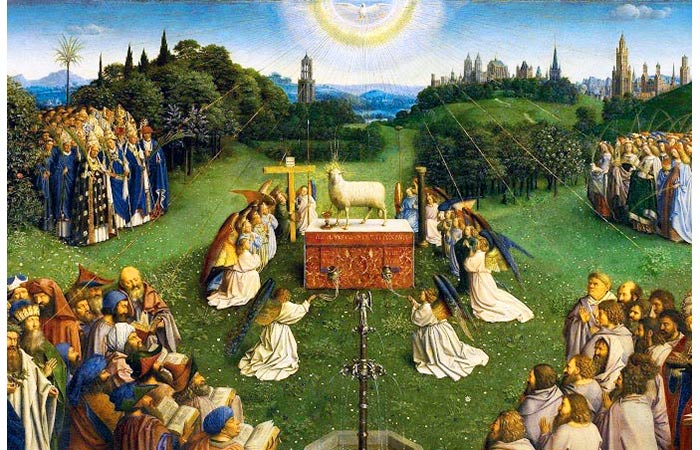Earthly and Heavenly
The Letter to the Hebrews gives us an image of Christ’s resurrection:
Christ has entered, not into a sanctuary made with hands, a copy of the true one, but into heaven itself, now to appear in the presence of God on our behalf” (Hebrews 9:24). As a result, “we have [a perfect] high priest, one who is seated at the right hand of the throne of the Majesty in heaven, a minister in the sanctuary and the true tent which is set up not by man but by the Lord.
Hebrews 8:1-2
Hebrews tells us that the earthly temple in Jerusalem was made by human beings to be a copy of the true temple (Hebrews 8:5). Israelite workmen were able to make it as a copy because God revealed the “pattern” to Moses. We might say God showed him a model from which a blueprint could be made. The true temple is heaven itself, and the true holy of holies is before the very throne of God.
Christ was not an earthly priest. He would not have been allowed into the court of priests in the earthly temple, much less the earthly holy of holies. Nor would he have been interested in trying to enter. His was a new covenant priesthood rather than an old covenant priesthood, meant to be exercised in a heavenly way rather than an earthly way.
Christ’s death on the cross was an earthly event with heavenly consequences. It happened on earth, because that is where Christ died. The consequences are heavenly because God’s reception of Christ’s death as the payment and atonement for the sins of human beings made the redemption possible. Christ the Priest made the connection between earth and heaven. Yet how that connection happened is not easy to state with accuracy.
Some Christian teachers stress that Christ’s death was a sacrifice completed on earth. Usually they also say that he was likewise a priest on earth offering his life to the Father on the cross, an earthly altar. Perhaps the strongest support for this view comes from the Gospel of John. At the moment of his death, “knowing that all was now finished” (John 19:28), Christ said, “It is finished” (v. 30). He bowed his head and “gave up his spirit” or, perhaps, “gave over the spirit” (v. 30). Then in an unusual event, blood and water, the two instruments of purification, flowed from his side (v. 34). It seems likely that in these details John is describing the death of Christ on earth as the sacrifice that achieves the redemption of the world through purification from sins and the gift of the Spirit. From this passage among others many Christian teachers have developed the phrase “the finished work of Christ” (on Calvary).
Other Christian teachers speak of the resurrection and ascension of Christ as the completion of the sacrifice of Christ on the cross. Some of them go so far as to speak of the heavenly sacrifice of Christ. They do not mean that he offered two sacrifices but that the earthly sacrifice was somehow completed in heaven.
They usually base what they say on the Book of Hebrews. They point out that Hebrews says Christ would not be a priest on earth, but that his priestly ministry must be in heaven (Hebrews 8:4). Moreover, he must have had something to offer in heaven if he were to minister as a priest (Hebrews 8:3–4). In addition, Hebrews says he is now appearing in the presence of God on our behalf (Hebrews 9:24). They also observe that the High Priest on the Day of Atonement poured out the blood on the altar and then took it into the Holy of Holies to sprinkle it before the earthly throne of God. The Letter to the Hebrews seems to connect this second step with Christ’s ascension into heaven (Hebrews 9:11-12, 24).
Both positions are based on truths and have much to be said for them. To discuss them adequately would go beyond what is possible here. Properly understood, they likely are not, in fact, incompatible with one another. They do, however, certainly stress two different truths. One position stresses that the earthly death of Jesus on the cross was the full satisfaction for the sins of the world. Nothing further was needed to pay for human redemption, nor did he in any way die again or offer another sacrifice. The other position stresses that his death on the cross was only effective as it was presented to God in heaven, and that presentation in some way is the work of the risen Christ as the heavenly High Priest.
Both truths have a place in the full understanding, although it is difficult to find the best way to speak about how they can be combined. Moreover, even if we take the strongest view of the completion of Christ’s sacrifice on the cross, there are still many features of the resurrection and ascension that can only be understood as connected to sacrifice and can best be described in sacrificial terms. Three sacrificial terms are especially important: acceptance, intercession, and blessing.
Acceptance
“Acceptance” or “acceptability” translates a Hebrew word commonly used in sacrificial contexts to indicate that someone or something meets with God’s approval. He therefore “accepts” or receives it. In English, to say that someone is “acceptable” to God would be somewhat grudging. It is a word we might use in the process of hiring a new employee to indicate that someone is merely still in the running. The scriptural word is more positive. It indicates that someone or something actually meets with God’s favor or approval and is something he wants.
Both people and sacrifices could be acceptable to God. In fact, sacrifices were intended to make people acceptable to God. Leviticus describes a sacrifice this way: “If his offering is a burnt offering from the herd, he shall offer a male without blemish; he shall offer it at the door of the tent of meeting, that he may be accepted before the Lord; he shall lay his hand upon the head of the burnt offering, and it shall be accepted for him to make atonement for him” (Leviticus 1:3–4).
The result of sacrifice, then, was to make the worshiper accepted by God, established in friendship with him. In order to do that, however, the offering itself had to be accepted by God, and therefore it had to be acceptable to him. This passage mentions three requirements for the acceptance of a sacrifice. It had to be a male animal of the right sort, without blemish, and offered in the tent or temple ordained by God.
Christ himself fulfilled all these requirements for the new covenant. He was the Lamb provided by God, without the blemish of sin, and offered in the true tent of heaven. But because he fulfilled the requirements of sacrifice in an unprecedented way, the acceptance of his offering could not be presumed, as the Israelites in the Old Testament had presumed the acceptance of old covenant sacrifices.
A similar situation of uncertainty occurred when Solomon built the temple to replace the tent of meeting. When it came time to offer sacrifice there, the Israelites needed some attestation of God’s acceptance of the new temple and therefore of sacrifices offered there. Second Chronicles describes what happened: “When Solomon had ended his prayer, fire came down from heaven and consumed the burnt offering and the sacrifices, and the glory of the Lord filled the temple” (2 Chronicles 7:1).
The fire that consumed the sacrifices and the glory that filled the temple served a similar function. Like the pillar of fire and the pillar of cloud in the wilderness, they were visible manifestations of the presence of the Lord. The cloud of glory that filled the temple indicated that God accepted the temple and made it his house. The fire that came down upon the sacrifices indicated that God accepted the sacrifices and took them to himself. This special manifestation of God’s action indicated to the people of Israel that the new temple was the place chosen by God as the true holy place where sacrifices could be acceptably offered.
In a similar way, the resurrection of Christ was the manifestation of the acceptance of Christ’s offering. He had been put to death outside the temple. As he lay dead in the tomb, the glory of God came upon Christ in a new way. God’s presence and power filled him the way the cloud filled the temple, entered into him and transformed him as the fire had consumed the offering. By his glorification, Christ’s humanity was taken by God and so became holy in a new way, holy as a sacrificial offering. In fact, as a sin offering it became “most holy” (Leviticus 10:17). At the same time, his humanity was transformed in such a way that it could enter heaven and function in a heavenly mode.
The resurrection and ascension were the heavenly reception of the sacrificial victim. They were either the actual acceptance of the sacrifice or else the manifestation of that acceptance. The sacrificial Lamb was now God’s in a new way, a gift given in sacrifice and received by God. It was therefore manifestly able to make the worshipers for whom it was offered acceptable to God.
Intercession and Blessing
The next two sacrificial terms, intercession and blessing, are best treated together. Most sacrifices were offered for some benefit the worshipers wished to receive from God. This may not have been true of the burnt offering, which symbolized a complete giving to God with nothing received in return. It was, however, true of the sin and guilt offerings by which Israelite worshipers sought forgiveness for their sins. It was also true of the peace or communion offerings, which were offered as part of a petition for some favor, as a thanksgiving for some favor granted, or simply as a free expression of love to God and desire to strengthen their relationship with him.
The offering of sacrifices involved both intercession and an impartation of a blessing. We have a description from about 200 B.C. of the high priest Simon offering sacrifice in a service. This account concludes by saying,
And the people besought the Lord Most High
Sirach 50:19-21
in prayer before him who is merciful,
till the order of worship of the Lord was ended;
so they completed his service.
Then Simon came down, and lifted up his hands
over the whole congregation of the sons of Israel,
to pronounce the blessing of the Lord with his lips,
and to glory in his name;
and they bowed down in worship a second time,
to receive the blessing from the Most High.
As this passage makes clear, both intercession and blessing were part of the sacrificial ceremony. As the gift was being given to God, intercession was being made. The sacrifice by itself could be considered as intercessory, because the prayers that accompanied the sacrifice only put into words the purpose of the gift. Sacrifice was a way of seeking God’s grace and blessing.
At the conclusion of the ceremony, the priest imparted a blessing. Behind this was a conviction that an acceptable sacrifice would bring blessing. Since the priest knew how to offer an acceptable sacrifice, he simply pronounced the closing blessing upon the worshiper, confident that God’s blessing would be given. The verbal blessing expressed the actual blessing that resulted from an acceptable sacrifice that a duly consecrated priest had offered.
Both aspects are present in Christ’s priestly service. As a priest, he makes intercession before God for his people. He is in heaven “now to appear in the presence of God on our behalf” (Hebrews 9:24). “He is able for all time to save those who draw near to God through him, since he always lives to make intercession for them” (Hebrews 7:25). We will not be condemned by “Christ Jesus who died, yes, who was raised from the dead, who is at the right hand of God, who indeed intercedes for us” (Romans 8:34).
There is, in other words, an ongoing priestly intercession of Christ, and it has our redemption as its object. He intercedes for us that we might be blessed as a result of his sacrificial offering. That offering makes us acceptable to God. His intercession may or may not be verbal, but the very presence of the Lamb who has been slain for us before the heavenly throne of God is itself a presentation of the sacrifice on the cross to the Father. In view of that sacrifice, God is gracious to us.
We should not necessarily think of the intercession of Christ as a set of actions by which he responds to our prayers for particular favors. Every time one of his followers prays, he probably does not get up from his throne, stand before his Father again, and ask his Father to grant the favors being sought. His intercession is rather a single eternal intercession that we be acceptable to God and that we receive forgiveness of our sins and the new life for which his sacrifice was offered. That intercession puts us into a relationship with God that allows us to make petitions for particular favors and be heard by God (John 16:23-24).
As a priest Christ also imparts a blessing. At the end of the Gospel of Luke there is a description of the risen Christ that probably shows his priestly blessing. He had manifested his resurrection by appearing in the midst of his disciples. He then explained the crucifixion and resurrection, concluding with the prediction of the outpouring of the Holy Spirit: “‘and behold, I send the promise of my Father upon you; but stay in the city, until you are clothed with power from on high.’ Then he led them out as far as Bethany, and lifting up his hands he blessed them” (Luke 24:49-50). It is probably not an accident that Jesus blesses his disciples in a priestly way and does so right after promising the Holy Spirit, since the gift of the Spirit embodies what Christ’s sacrifice was meant to bring.
The Holy Spirit, as Paul says, is the promised blessing (Galatians 3:14). He is the fulfillment of the promise of the reversal of the fall that had been pledged to Abraham and his faith, because the gift of the Spirit brings about the reversal of the fall in those who receive him (Gal 3:6-14). The Spirit is the source of the new life (2 Corinthians 3:6), the first installment given as a guarantee of the full possession of the heavenly inheritance (Ephesians 1:13-4). He brings the initial presence of the kingdom of God (Romans 8:18-25). The Holy Spirit, in other words, brings all the blessings of the new covenant, given as a result of Christ’s sacrifice.
The Holy Spirit, however, could not be given to the disciples until Christ’s sacrificial gift was presented in heaven through his resurrection and ascension. John said of the situation before Christ’s death, “The Spirit had not been given, because Jesus was not yet glorified” (John 7:39). Christ’s blessing of his disciples described in Luke 24, then, was the action of the risen Lord. He had probably already ascended initially (John 20:17), and was calling down that gift which would surely be given to his disciples some days later. Christ’s blessing was an action of the High Priest appointed by God, who knew that he had offered an acceptable sacrifice and knew that he was authorized to call the blessing of the Holy Spirit down upon those who belonged to him.
However we state the relationship between the earthly and heavenly aspects of the sacrifice of Christ, his death on the cross is the cause of the blessing and salvation Christ came to bring. The cross on earth was the point of atonement and satisfaction. Sin came into existence on earth and was atoned for on earth. But the change in relationship with God and the consequent change in human lives is heavenly and eternal, because God dwells in heaven and in eternity. Christ makes the connection in his priestly ministry. He is before God, presenting the acceptable sacrifice, the offering of himself, and on that basis interceding for his people. Since his sacrifice is the one God wanted, Christ’s intercession is heard and the blessing of new life is given.
The Victory and Exaltation of the Redeemer – A 3 Part series, by Steve Clark
This 3 Part Series on The Victory of the Redeemer is excerpted from Redeemer: Understanding the Meaning of the Life, Death, and Resurrection of Jesus Christ, Chapter Ten, by Steve Clark © 1992, 2009. A free PDF copy of the book is available online for download from the Sword of the Spirit website. Check out other Sword of the Spirit books from the Sword of the Spirit Online Library.
Top image credit: The Adoration of the Lamb (detail), from the Ghent Altarpiece, painted by Jan van Eyck in 1432. Image in the Public Domain. Source: https://www.wikiart.org/en/jan-van-eyck/adoration-of-the-lamb-1429
Steve Clark has been a founding leader, author, and teacher for the Catholic charismatic renewal since its inception in 1967. Steve is past president of the Sword of the Spirit, an international ecumenical association of charismatic covenant communities worldwide. He is the founder of the Servants of the Word, an ecumenical international missionary brotherhood of men living single for the Lord.
Steve Clark has authored a number of books, including Baptized in the Spirit and Spiritual Gifts, Finding New Life in the Spirit, Growing in Faith, and Knowing God’s Will, Building Christian Communities, Man and Woman in Christ, The Old Testament in Light of the New.
- See articles by Steve Clark in Living Bulwark Archives



